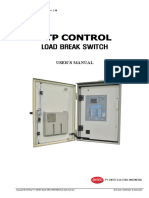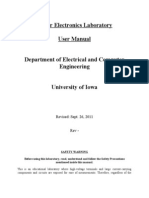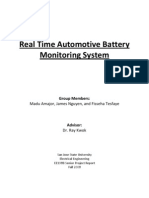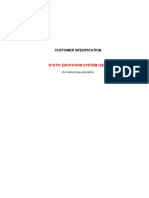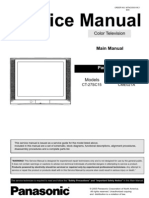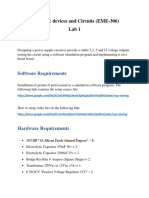App Note Solar Impedance V1 0 0
App Note Solar Impedance V1 0 0
Uploaded by
VickySvjCopyright:
Available Formats
App Note Solar Impedance V1 0 0
App Note Solar Impedance V1 0 0
Uploaded by
VickySvjCopyright
Available Formats
Share this document
Did you find this document useful?
Is this content inappropriate?
Copyright:
Available Formats
App Note Solar Impedance V1 0 0
App Note Solar Impedance V1 0 0
Uploaded by
VickySvjCopyright:
Available Formats
Bode 100 - Application Note
Solar Cell Impedance
Page 1 of 9
Solar Cell Impedance Measurement
using the Bode 100
By Florian Hmmerle
2011 Omicron Lab V1.0
Visit www.omicron-lab.com for more information.
Contact support@omicron-lab.com for technical support.
Smart Measurement Solutions
Bode 100 - Application Note
Solar Cell Impedance
Page 2 of 9
Table of Contents
1 Introduction .................................................................................................................3
2 Measurement Setup ....................................................................................................4
2.1 High Impedance Bridge ...........................................................................................4
2.2 DC Bias Injector ......................................................................................................5
3 Device Configuration ..................................................................................................6
4 Calibration ...................................................................................................................7
5 Measurement & Results ..............................................................................................7
6 Conclusion ...................................................................................................................9
Note: Basic procedures such as setting-up, adjusting and calibrating the Bode 100
are described in the Bode 100 user manual.
Note: All measurements in this application note have been performed with the
Bode Analyzer Suite V2.32. Use this version or a higher version to perform the
measurements detailed in this application note. You can download the latest
version at http://www.omicron-lab.com/downloads.html.
Smart Measurement Solutions
Bode 100 - Application Note
Solar Cell Impedance
Page 3 of 9
1 Introduction
The impedance of a solar cell depends on the frequency and the operating point of the
cell. It can therefore make sense to dynamically characterize photovoltaic (PV) modules.
In this document we show a method how to measure the dynamic impedance of a PV
module using the frequency response analyzer Bode 100. For simplification the
impedance of the solar cell is measured in a dark environment. The operating point is
then chosen by applying an external DC1 voltage bias. In this document we show how
the AC2 impedance of a PV module can be measured using the Bode 100 in conjunction
with the J2130A DC Bias Injector from Picotest.
Figure 1: Solar Cell under test soldered to a BNC connector
The figure below shows a simplified equivalent circuit model of a photovoltaic module.
Figure 2: Dynamic equivalent circuit model
The equivalent circuit consists of the following parameters which can determined by the
measurements detailed in this document:
1
2
parallel capacitance (consists of the diffusion- and the transition capacitance)
parallel resistance
(dynamic resistance of the diode)
series resistance
Direct Current
Alternating Current
Smart Measurement Solutions
Bode 100 - Application Note
Solar Cell Impedance
Page 4 of 9
2 Measurement Setup
2.1 High Impedance Bridge
The impedance of the examined photovoltaic module is very high (in the range of
several
). To improve the measurement accuracy in this impedance range, the
following impedance measurement bridge is used in conjunction with the Bode 100:
Figure 3: high impedance Measurement Bridge
The bridge can be built up with standard resistors as shown in the following figure. The
impedance calibration of the Bode 100 will compensate the parasitics of the bridge.
Figure 4: built up Measurement Bridge
Smart Measurement Solutions
Bode 100 - Application Note
Solar Cell Impedance
Page 5 of 9
2.2 DC Bias Injector
We need to bias the solar cell with a DC voltage during the measurement. To protect the
Bode 100 source we need to block the DC voltage. This can be done using the DC Bias
Injector from Picotest. The following picture shows the final measurement setup with the
Bode 100 connected to the measurement bridge and the DC Bias Injector placed
between the solar cell and the measurement bridge. The DC bias voltage is applied
using a laboratory power supply.
High impedance
measurement bridge
DC Bias
Voltage Supply
Picotest DC Bias
Injector
Solar cell under test
Figure 5: Measurement Setup
Note:
We measure the solar cell under dark conditions and control the applied DC
voltage. Therefore the solar cell needs to be protected from light during the
measurements!
Note:
Further details and information regarding the J2130A DC Bias Injector can be
found in the Application note: "DC Biased Impedance Measurements",
available from our webpage: http://www.omicron-lab.com/applicationnotes/dc-biased-impedance-measurement
Smart Measurement Solutions
Bode 100 - Application Note
Solar Cell Impedance
Page 6 of 9
3 Device Configuration
Measurements with the high impedance measurement bridge are performed in the
Frequency Sweep (External Coupler) mode of the Bode Analyzer Suite:
Further settings are chosen as shown below:
Start Frequency:
Stop Frequency:
Sweep Mode:
Number of Points:
Level:
Attenuator CH1 & CH2:
Receiver Bandwidth:
10 Hz
100 kHz
Logarithmic
201 or more
0 dBm
0 dB
10 Hz
The settings for trace 1 & 2 are chosen as follows:
Before the measurement can be started, the setup has to be calibrated.
Smart Measurement Solutions
Bode 100 - Application Note
Solar Cell Impedance
Page 7 of 9
4 Calibration
We recommend performing a User Calibration for accurate results. The calibration
window is opened by clicking on the User Calibration Icon:
OPEN, SHORT and LOAD calibration needs to be performed:
OPEN:
Nothing is connected to the
measurement output of the Bias
injector (infinite impedance)
SHORT:
A short circuit is connected to
the measurement output (zero
impedance)
LOAD:
A known resistor is connected.
We recommend using a 1k
resistor for the load calibration.
Before starting the calibration,
set the load resistor value
according to your used resistor!
After having performed the calibration the measurement can be started.
5 Measurement & Results
30000
25000
-2000
20000
-4000
15000
-6000
10000
-8000
5000
-10000
0
101
102
103
104
f/Hz
TR1: Real(Impedance)
Smart Measurement Solutions
TR2: Imag(Impedance)
105
TR2/Ohm
TR1/Ohm
A DC bias voltage of 5.6 V is applied to the photovoltaic module. This results in a
voltage drop of 0.7 V per cell (8 cells are connected in series in the examined cell)
Starting a single sweep (
) results in the following curve:
Bode 100 - Application Note
Solar Cell Impedance
Page 8 of 9
From this curve the equivalent circuit model of the PV module can be derived. At low
{ }
frequencies the real part of the impedance equals
. At
the
{ }
real part of the impedance equals
.
TR1/Ohm
25000
20000
15000
10000
5000
0
101
102
103
104
105
f/Hz
TR1: Real(Impedance)
From these results the resistors of the equivalent circuit model can be calculated as
follows:
The capacitance can be derived from the measured admittance of the photovoltaic
module. Neglecting the series resistance the capacitance can directly be measured in
the Bode Analyzer Suite by selecting:
Measurement: Admittance
Format: Cp.
This results in a parallel capacitance of
.
We therefore arrive at the following simplified equivalent circuit model of the measured
photovoltaic module:
Note: This model is only valid for a bias voltage of
applied to the photovoltaic
module.
The parameters depend on the applied DC voltage respectively the amount of
light the solar cell is exposed to.
Smart Measurement Solutions
Bode 100 - Application Note
Solar Cell Impedance
Page 9 of 9
As mentioned the parameters depend on the applied DC bias voltage. Different bias
voltages lead to different results. The following curves show the real and imaginary part
of the module impedance with 0.55 V, 0.6 V, 0.65 V and 0.7 V bias voltages per cell
applied to the photovoltaic module. (The module consists of 8 cells therefore the total
voltage equals 8 times the voltage per cell)
6 Conclusion
In this document we demonstrate how the AC impedance of a photovoltaic module or a
single solar cell can be measured using the Bode 100 in conjunction with the Picotest
J2130A DC-Bias Injector. The results from this measurement can be used to derive a
dynamic small signal model of the solar cell. Such models help to ensure the stability of
solar driven power systems with e.g. solar cell arrays and voltage regulators.
Smart Measurement Solutions
You might also like
- MA 2067 - Demoboard Exercises - ANG - Ver 1.0 - 20 751 045Document46 pagesMA 2067 - Demoboard Exercises - ANG - Ver 1.0 - 20 751 045Ivan HuamaniNo ratings yet
- App Note DC DC Stability V2Document17 pagesApp Note DC DC Stability V2ranjitheee1292No ratings yet
- App Note Battery Impedance V1 0Document8 pagesApp Note Battery Impedance V1 0zafer zenNo ratings yet
- App Note EMC Filter Insertion Loss Simulation V1Document26 pagesApp Note EMC Filter Insertion Loss Simulation V1Rohit SainiNo ratings yet
- CableCALC BS 7671 Reference ManualDocument24 pagesCableCALC BS 7671 Reference Manualjodie_patrick80% (5)
- DC/DC Converter Stability Measurement: Bode 100 - Application NoteDocument18 pagesDC/DC Converter Stability Measurement: Bode 100 - Application NotekoolniranNo ratings yet
- ETP Control ETMFC610 - Manual - Control Box - Ver1.00Document24 pagesETP Control ETMFC610 - Manual - Control Box - Ver1.00kemalNo ratings yet
- Voltage Ratings of High Power Semiconductors: Product InformationDocument11 pagesVoltage Ratings of High Power Semiconductors: Product InformationAditi SinghNo ratings yet
- Method Statement For Partial Discharge Measurement: Application NoteDocument11 pagesMethod Statement For Partial Discharge Measurement: Application NoteInsan AzizNo ratings yet
- Impedance Measurements AgilentDocument15 pagesImpedance Measurements AgilentA. VillaNo ratings yet
- COMPANO 100 Whats New V2 - 40Document17 pagesCOMPANO 100 Whats New V2 - 40startservice.cpsNo ratings yet
- Test Universe AppNote Testing ABB Relays With Sensor Inputs 2022 ENUDocument13 pagesTest Universe AppNote Testing ABB Relays With Sensor Inputs 2022 ENUAlonso Ferdinan PatawaranNo ratings yet
- ECA Lab ManualDocument73 pagesECA Lab ManualŚhãžįfRįžŵāñNo ratings yet
- Accident AlertDocument35 pagesAccident AlertChandra SekarNo ratings yet
- Loop Gain MeasurementDocument7 pagesLoop Gain MeasurementgubiliNo ratings yet
- Field-Testing of Power Semiconductor Modules: Application NoteDocument11 pagesField-Testing of Power Semiconductor Modules: Application NotecsystemsNo ratings yet
- CT Z1425 FinalDocument33 pagesCT Z1425 FinalRodolfo ArosemenaNo ratings yet
- Exp 2Document7 pagesExp 2Saim HaqNo ratings yet
- Lighting Arrester UpdatedDocument7 pagesLighting Arrester Updatedzahid anwar zahid anwarNo ratings yet
- BFM2801 Mechatronic Lab 03 Diode ApplicationDocument10 pagesBFM2801 Mechatronic Lab 03 Diode ApplicationMohdAzizul ZainalAbidinNo ratings yet
- Devzone Cda Tut P Id 3602Document2 pagesDevzone Cda Tut P Id 3602velavansuNo ratings yet
- VSC Product Introduction-EnDocument36 pagesVSC Product Introduction-EnAldeni Prima AnugrahNo ratings yet
- WattMeter PDFDocument15 pagesWattMeter PDFEngr Mohammed Aqeel Khan0% (1)
- App Note Transformer Modelling V 2 0Document20 pagesApp Note Transformer Modelling V 2 0owenremotekNo ratings yet
- 03-10-2011 110815 Photovoltaic-Application-GuideDocument20 pages03-10-2011 110815 Photovoltaic-Application-GuideMárcio CruzNo ratings yet
- Lab 01 Introduction To Electrical Network Analysis LabDocument15 pagesLab 01 Introduction To Electrical Network Analysis LabI190845 Samana NayyabNo ratings yet
- Lab 8 - Power Supply Design 2022Document16 pagesLab 8 - Power Supply Design 2022ain shikroniNo ratings yet
- LabDocument31 pagesLabazmyzumaNo ratings yet
- Models - Acdc.power InductorDocument16 pagesModels - Acdc.power InductorJaja LocoNo ratings yet
- Power Electronics Lab ManualDocument68 pagesPower Electronics Lab ManualJonathan727No ratings yet
- Real Time Automotive Battery Monitoring System - ReportDocument30 pagesReal Time Automotive Battery Monitoring System - ReportOmkar MaliNo ratings yet
- Pe Lab 10-200708Document15 pagesPe Lab 10-200708Omar JanjuaNo ratings yet
- Customer Specification: Static Excitation System (Ses)Document18 pagesCustomer Specification: Static Excitation System (Ses)Ravindra JadhavNo ratings yet
- Crown DC300A PDFDocument42 pagesCrown DC300A PDFJLGONZALEZ7No ratings yet
- Practical Assignment HVEDocument13 pagesPractical Assignment HVEboetabradNo ratings yet
- CableCALC BS 7671 Operating ManualDocument17 pagesCableCALC BS 7671 Operating Manualjodie_patrickNo ratings yet
- CT27SC15Document42 pagesCT27SC15Joaquin MuzquizNo ratings yet
- Pe Lab 11-200708Document15 pagesPe Lab 11-200708Omar JanjuaNo ratings yet
- HIQUEL Snubber AppNote en 0100Document4 pagesHIQUEL Snubber AppNote en 0100bob75No ratings yet
- Det01cfc High Speed Detector IngaasDocument20 pagesDet01cfc High Speed Detector Ingaasnithin_v90No ratings yet
- 8600 Accuracy TestingDocument12 pages8600 Accuracy TestingAie EnkhusairiNo ratings yet
- Arrester Faqs: Page 36 - March 2012Document9 pagesArrester Faqs: Page 36 - March 2012anjes1No ratings yet
- Electronic Devices and Circuits (EME-306) Lab 1: ObjectiveDocument7 pagesElectronic Devices and Circuits (EME-306) Lab 1: ObjectiveAhmed SayedNo ratings yet
- Paper 02Document4 pagesPaper 02Md ShafiullahNo ratings yet
- 5988 5511enDocument8 pages5988 5511enthangaraj_icNo ratings yet
- lh040 - lh041Document41 pageslh040 - lh041WOLFGANG84No ratings yet
- Primary Injection Testing On Low-Voltage Circuit Breakers - NETAWORLD JOURNALDocument13 pagesPrimary Injection Testing On Low-Voltage Circuit Breakers - NETAWORLD JOURNALneoph138100% (1)
- bpw34 AvrDocument4 pagesbpw34 AvrNedim Avicena AlićNo ratings yet
- Current Sensing Rev.1.1Document18 pagesCurrent Sensing Rev.1.1kollanegeenNo ratings yet
- Awa A56010 VoltohmystDocument32 pagesAwa A56010 VoltohmystauthelloNo ratings yet
- Locating Faults AG en US1Document3 pagesLocating Faults AG en US1Neelakandan MasilamaniNo ratings yet
- Test Equipment For AC/DC Drive and Power Electronic MeasurementsDocument6 pagesTest Equipment For AC/DC Drive and Power Electronic MeasurementsLin ChongNo ratings yet
- Micro VoltmeterDocument6 pagesMicro Voltmeteranto_hardianto443No ratings yet
- Solenoid Lab ManualDocument17 pagesSolenoid Lab Manualbrandon999No ratings yet
- Influence of System Parameters Using Fuse Protection of Regenerative DC DrivesFrom EverandInfluence of System Parameters Using Fuse Protection of Regenerative DC DrivesNo ratings yet
- Introduction to Power System ProtectionFrom EverandIntroduction to Power System ProtectionRating: 5 out of 5 stars5/5 (1)
- Reference Guide To Useful Electronic Circuits And Circuit Design Techniques - Part 1From EverandReference Guide To Useful Electronic Circuits And Circuit Design Techniques - Part 1Rating: 2.5 out of 5 stars2.5/5 (3)






